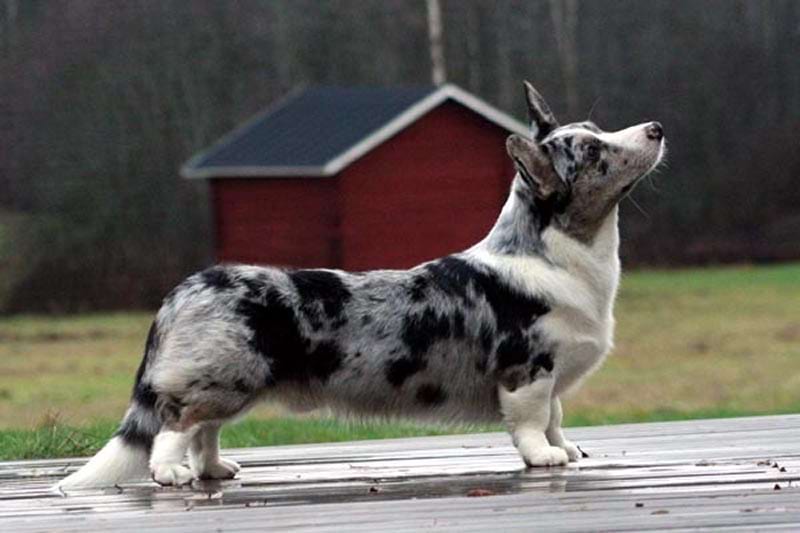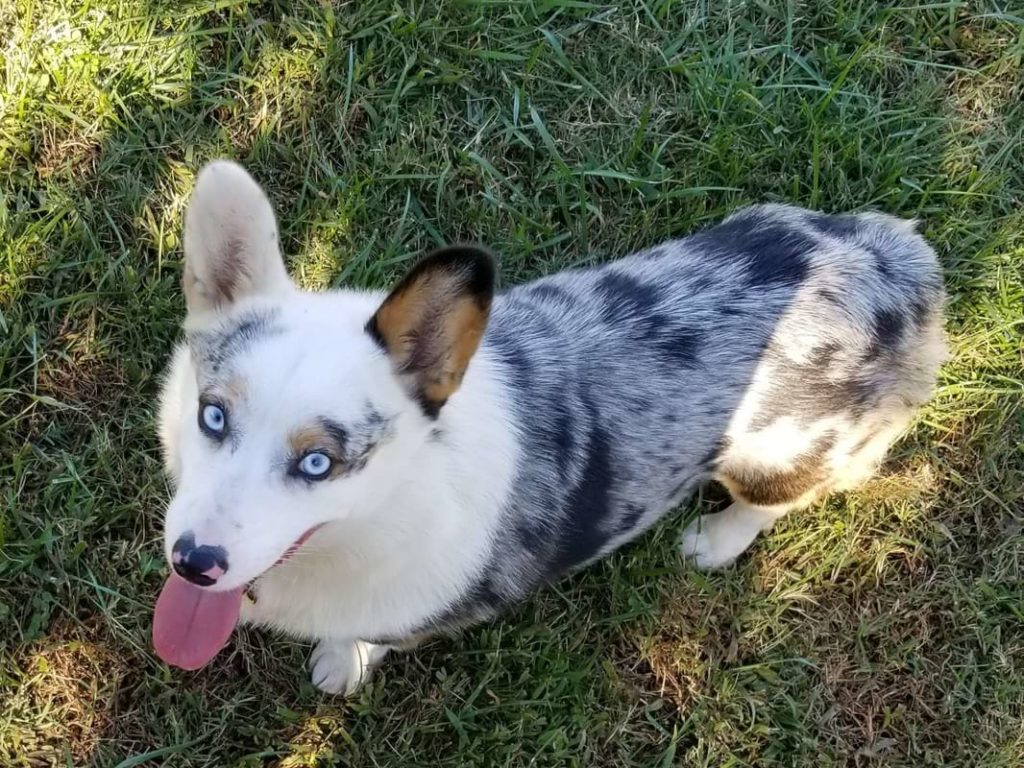The Blue Merle Corgi is a beautiful dog breed that has recently gained popularity. Known for their distinctive blue-grey coat pattern, these dogs are a unique and rare variation of the beloved Welsh Corgi. Their compact size and charming demeanor make them popular among dog lovers everywhere.
However, owning a Blue Merle Corgi comes with its challenges and responsibilities, and it’s essential to understand the breed’s characteristics and needs before bringing one into your home.
In this article, we’ll delve deeper into the history, appearance, temperament, and care requirements of the Blue Merle Corgi, so you can decide if this delightful dog fits you.
Brief overview of Blue Merle Corgi
| Purity | Purebred |
| Purpose | Companion dog |
| AKC Recognition | Yes |
| Size | Medium |
| Weight | 25-38 pounds |
| Height | 10.5-12. 5 inches |
| Coat Colors | Blue, White, Red, Gray, Black |
| Exercise Needs | Moderate-High |
| Lifespan | 12-15 years |
| Puppy Costs | $1,200-$10,000 |
What is a Blue Merle Corgi?

A Blue Merle Corgi is a variety of the Welsh Corgi breed that exhibits a unique coat color pattern known as “blue merle.” This coat pattern is characterized by a marbled or mottled appearance with patches of gray, black, and sometimes white. Blue merle Corgis are known for their striking and eye-catching coat, which sets them apart from the more common tri-color (black, tan, and white) or red varieties of Corgis.
Blue merle is a genetic color variation that results from the presence of the merle gene, which can affect pigmentation in a dog’s coat. It’s important to note that while the blue merle coat is visually distinctive and attractive, it doesn’t impact the Corgi’s temperament or overall health. Blue merle Corgis share the same charming and friendly personality traits as other Corgi varieties, making them beloved pets and companions.
Interesting Facts You Need to Know
1.There Are Two Separate Corgi Breeds
In the world of Corgis, there’s more than meets the eye. While many people may assume that there’s only one breed of Corgi, the truth is that there are two distinct types – the Pembroke Welsh Corgi and the Cardigan Welsh Corgi. And while some may think that these two breeds are interchangeable, that couldn’t be further from the truth.
2.Discovering Corgis from Wales
When it comes to the origins of the Corgi, there’s a rich history to uncover. These beloved dogs may be small, but they have a big story. It all started in Wales, where Corgis were initially bred to work as farming dogs. But not all Corgis were created equal – two distinct types hail from different regions of Wales.
The Pembroke Welsh Corgi, for example, is from the southern portion of Wales. These pups were prized for their herding abilities, which helped farmers manage their livestock more efficiently. But while the Pembroke may have been a common sight in southern Wales, another type of Corgi had its roots further north.
3.Rarity and Cost of Merle Corgis
In the world of Corgis, there are plenty of unique colors and patterns to choose from. But if you’re looking for a blue Merle Corgi, be prepared to dig deep into your pockets. This stunning color pattern is one of the rarer ones out there, which means that blue merle Corgi puppies can come with a hefty price tag.
If you’re hoping to add a blue Merle Corgi to your family, you can expect to spend anywhere from $1,000 to $5,000 or more. That’s because breeders carefully select this color pattern, which can take time to achieve. The result is a dog that is not only visually striking but also unique.
4.Unearthing the Rodent Control
Corgis may be known for their adorable appearance and playful personalities, but these dogs have a fierce working history. Corgis were once employed as rodent control dogs on farms throughout their native Wales.
Despite their small size, Corgis were skilled hunters and could keep farms free of pesky rodents like rats and mice. While cats often get all the credit for this type of work, Corgis were just as capable of handling business.
5.Cattle Herding Past of Corgis
It’s no secret that Corgis are a breed of many talents, and their farming heritage is no exception. These dogs were once indispensable helpers on Welsh farms, where they put their skills to work herding livestock.
But while many people associate herding dogs with larger breeds like the Border Collie or Australian Shepherd, Corgis were just as capable of getting the job done. Their small size and elegant frames made them well-suited for herding cattle and other livestock like sheep and goats.
Can “Corgi” be used to refer to a Blue Merle Corgi?
Yes, the term “Corgi” can be used to refer to a Blue Merle Corgi, specifically the Cardigan Welsh Corgi breed.
Blue Merle Corgis, with their striking coat pattern and often mesmerizing blue eyes, are indeed a sight to behold. However, it’s important to note that this distinctive look is typically associated with the Cardigan Welsh Corgi breed, not the Pembroke Welsh Corgi. The Cardigan Welsh Corgi possesses a dominant dilution gene that creates the beautiful patchwork of colors characteristic of the Blue Merle coat, while the Pembroke Welsh Corgi does not have this genetic trait.
So, if you’re considering adding a Blue Merle Corgi to your family, make sure to look for a Cardigan Welsh Corgi to get that unique and captivating appearance. While they may be rarer and more expensive than other Corgi varieties, their beauty and charm make them a worthwhile investment for those who appreciate a visually stunning canine companion.
Parent Breeds of Blue Merle American Corgi
An American Corgi is not purebred but a cross between the Pembroke and the Cardigan Corgi. The Blue Merle American Corgi gets the Merle pattern from the Cardigan Corgi.
Origins and history of Cardigan Welsh Corgi

With roots tracing back to the Teckel hound family, the Cardigan Welsh Corgi hails from Wales’s lush and green Cardiganshire region. Historically, these hearty little dogs played an essential role in cattle herding, but their reputation extends far beyond the farm.
In fact, until 1934, the Cardigan and Pembroke Welsh Corgis were considered one breed, with the Cardigan being recognized as a separate breed with its distinct lineage.
Origins and History of Pembroke Welsh Corgi

Journey back to the 12th century, when Flemish weavers brought Spitz dogs to Wales’ Pembrokeshire county. These captivating canines, Pembroke Welsh Corgis, boast coats of red, sable, black, or tan, occasionally adorned with white markings.
While not purebred, the Pembroke Blue Merle Corgi captivates as a fascinating hybrid.
What Does a Blue Merle Corgi Look Like?
The Cardigan Welsh Corgi boasts a stout and robust body, small in stature yet mighty in build. Their length is particularly striking and proportionally elongated compared to their height. And don’t even get me started on their tails! These little fox-like appendages are just begging for a playful wag.
Moving up to the head, we find a wide and flat skull nestled between two sharp and pointy ears, large and leathery in appearance. And those eyes! Medium to large, with hues ranging from piercing blue to smoky gray or perhaps a blend of both. Indeed a sight to behold.

Size, height, and weight
The Blue Merle Corgi has a size similar to other Cardigan Corgis, but their height and weight may vary depending on their age. These dogs typically reach their maximum size, height, and weight around 12 months of age, but they can continue to grow until they are 14 months old, making it difficult to predict their exact adult size. Factors such as diet and exercise can also impact their growth and development.
| Weight (Males) | Height (Males) | Weight (Females) | Weight (Females) | |
| 3 months | 13 – 15 pounds | 5 – 7 inches | 10 – 14 pounds | 5 – 7 inches |
| 6 months | 23 – 28 pounds | 7 – 8 inches | 19 – 25 pounds | 7 – 8 inches |
| 1 year | 30 – 36 pounds | 10.5 – 12.5 inches | 24 – 32 pounds | 10.5 – 12.5 inches |
Coat colors and types
Blue Merle Corgis boast a captivating coat marked by marbled black and gray tones, accented by tan or brindle points. White flashings may adorn various body parts, making each one distinct. Although not a separate breed, this color pattern can appear in Cardigan Welsh, American, and crossbred Pembroke Corgis.
Temperament and Personality
The temperament and personality of the Corgi Blue Merle are quite fascinating. Being an intelligent breed, they have a strong inclination towards people and possess an excellent herding ability.
The Blue Merle Corgi can be an active dog and may show some stubbornness due to their independent nature. However, their tenacity and affectionate nature make them great companions for any household.
Is Blue Merle Corgi a good fit for families?
Yes. Blue Merle Corgis are fantastic family pets! They have a great temperament and are super affectionate and loyal to their human family. These dogs crave attention and love to be around their family members all the time, so be prepared for lots of cuddles and playtime.
They can be prone to separation anxiety, so make sure to give them lots of love and attention. Additionally, Cardigan Corgis are known for being great with other animals and pets, so they’re a great addition to multi-pet households.
Training

Training a Blue Merle Corgi can be a moderately easy task but requires patience and consistency. Although they tend to be stubborn, their willingness to please their owners makes them good learners.
Positive reinforcement and consistency are essential when training your Corgi. Obedience, socialization, and behavioral training are necessary for all Corgi puppies. Starting the training process at home, with fewer distractions, is recommended before introducing them to more stimulating environments like the dog park.
Socialization is important for all puppies, and the Blue Merle Corgi is no exception. Once they have mastered obedience and behavioral training, meeting other dogs, animals, and strangers is essential for their development. Through consistent training and socialization, your Corgi will be well-behaved and well-adjusted in any environment.
Exercise Requirements
The exercise requirements for Blue Merle Corgis are quite high because of their exceptional stamina. This is because of their natural inclination and aptitude for herding. To ensure that your Blue Merle Corgi remains healthy and robust, it is recommended that they receive an hour or two of daily exercise, both physically and mentally.
There are several ways to give your Blue Merle Corgi the required exercise. You can take them for a walk around the block or engage in activities such as fetch or tug of war with them in your backyard. These activities will help them maintain their physical fitness, stimulate their mental understanding, and help them release pent-up energy.
Living Conditions
Blue Merle Corgis can thrive in any living conditions in urban or rural settings. They are highly adaptable and can be trained by first-time dog owners.
Grooming and Cleaning
Attention all dog owners! Listen up if you want to keep your Blue Merle Corgi looking fabulous and healthy! The Cardigan Corgis have short coats, so they’re not high-maintenance pets. However, they’re heavy shedders, so you must brush them daily to keep your home free of hairballs.
But wait, there’s more! Their fur can also carry dander, saliva, and outdoor particles that can cause allergic reactions in sensitive family members. Don’t let those allergens ruin your day! Brushing and grooming your Blue Merle Corgi regularly can help minimize shedding and reduce allergens.
Are Blue Merle Corgis Hypoallergenic?
No, Corgis aren’t hypoallergenic. Blue Merle Corgis shed consistently year-round, which might not be suitable for people sensitive to allergens like dander and saliva.
Nonetheless, their affectionate and loyal disposition continues to make them a beloved choice for many families, despite shedding concerns.
Food and Diet
Regarding Blue Merle Corgi’s food and diet, providing them with a well-balanced and nutritious meal plan is essential. As an adult, they would need around 1.5 to 2 cups of dog food per day, divided into two separate meals.
It’s crucial to remember that the amount of food intake and the type of food can vary depending on the dog’s age, size, activity level, and health status. Moreover, it’s always a good idea to consult with your veterinarian to ensure your furry friend receives the proper nutrition.
You can also add healthy snacks to your Corgi’s diet, such as fruits and vegetables. However, it’s crucial to avoid feeding them human foods that may harm their health, such as chocolate, grapes, and onions.
Proper hydration is also vital, so always provide them with clean water. Finally, avoid overfeeding your Blue Merle Corgi, as obesity can lead to various health issues such as joint problems, diabetes, and heart diseases.
Common Health Issues

Hold onto your hats because we have news about Blue Merle Corgi’s health problems! Despite being known as generally healthy dogs, these little guys can still be susceptible to health issues. Here are a few you should be aware of:
1.Canine Degenerative Myelopathy
Canine degenerative myelopathy, also known as CDM, is a disorder that can devastate a dog’s spinal cord. CDM is a progressive condition that can lead to the loss of muscle control and mobility, ultimately leaving the dog unable to walk. This disease is more common in certain breeds, including Corgis.
2.Hip Dysplasia
Listen up, folks! Hip dysplasia is a genuine concern for some Corgis because of their stumpy legs. When the hip joints don’t develop properly, it can cause problems like pain and trouble getting around. Keep an eye out for any limping, stiffness, or difficulty moving, and get your furry friend checked out by a vet pronto.
3.Deafness
Hold on to your leashes, folks! If you’re considering adopting a Blue Merle Corgi, listen up. Merle dogs, including our beloved Corgis, can be more susceptible to deafness than other breeds. This is because of a chromosomal abnormality that can cause issues with the development of their hearing. It’s important to check for any signs of hearing loss in your furry friend and consult your vet to ensure their overall health and well-being.
4.Microphthalmia
Microphthalmia is when a dog has abnormally small eyeballs that can cause discomfort. It is not uncommon in certain dog breeds, including Blue Merle Corgis. When a dog has microphthalmia, their vision may also be affected, leading to further complications.
5.Willebrand’s disease
Microphthalmia is when a dog has abnormally small eyeballs that can cause discomfort. It is not uncommon in certain dog breeds, including Blue Merle Corgis. When a dog has microphthalmia, their vision may also be affected, leading to further complications.
How long Does Blue Merle Corgi live?
Blue Merle Corgis’s lifespan depends on various factors such as their overall health, genetics, and lifestyle. Generally, they can live up to 12 to 15 years. However, providing them with proper care and a balanced diet is essential to help them live healthy and long life.
Regular exercise, annual check-ups, and vaccinations can also contribute to their longevity. Furthermore, identifying potential health problems early on and taking prompt action can improve their quality of life and extend their lifespan.
How Much Is a Blue Merle Corgi?
Well, hold on tight because the price can vary greatly! On average, a Blue Merle Corgi puppy can cost around $2,000, but some can go as high as $10,000! The price can depend on the dog’s bloodline, the breeder, and other factors.
Is Blue Merle Corgi The Right Dog For Me?
If you’re wondering whether the Blue Merle Corgi is the right dog for you, consider this: if you’re an active person looking for a furry exercise buddy, a Blue Merle Corgi might be the perfect match for you! However, if you’re allergic to pet dander, think twice before bringing home this breed, as they shed a lot.
List of dogs that are similar to Blue Merle Corgi
- Corgi-Blue Heeler Mix
- Corgi-Dalmatian Mix
- Corgi-St. Bernard Mix
- Corgi-French Bulldog Mix
- Corgi-Boxer Mix
- Corgi-Pomeranian Mix
- Corgi-Pug Mix
- Corgi-Yorkie Mix
- Sable Corgi
- Corgi-Poodle Mix
- Fluffy Corgi
Conclusion
In conclusion, the Blue Merle Corgi is a captivating dog breed with a unique appearance and a lovable personality. While smaller, they are big on charm, and their energetic and affectionate nature makes them great companions for families and individuals alike.
However, as with any dog, owning a Blue Merle Corgi requires time, effort, and commitment to their care and well-being. Researching and understanding their needs before bringing one into your home is important.
Overall, if you’re looking for a loyal and entertaining furry friend, the Blue Merle Corgi is a breed worth considering.

Pingback: Sable Corgis 101: Everything You Need to Know 2023
Pingback: Corgi Yorkie Mix: Everything You Need to Know 2023
Pingback: Corgi Pug Mix 101: Everything You Need to Know 2023
Pingback: Fluffy Corgi: Unveiling the Beauty of this Rare Breed 2023
Pingback: Do Corgis Shed? Helpful Tips You Need to Know 2023